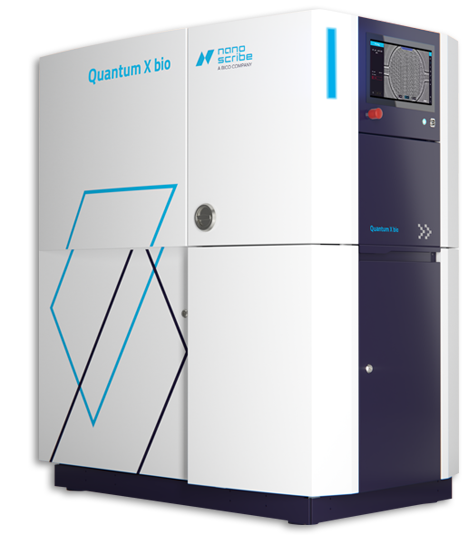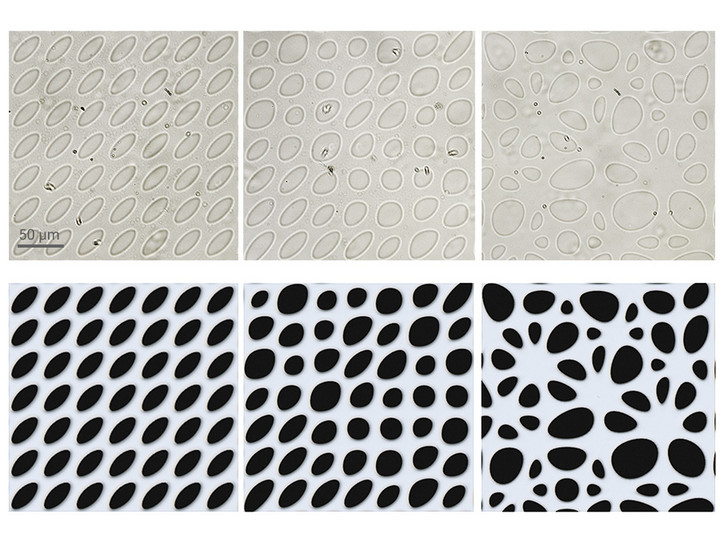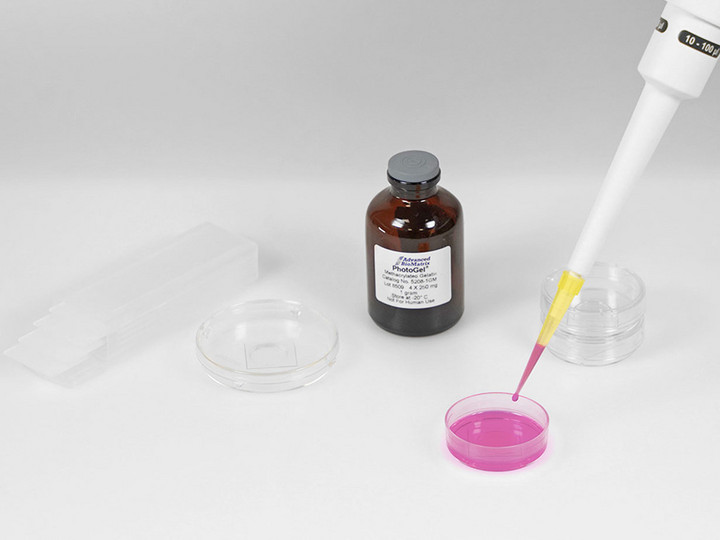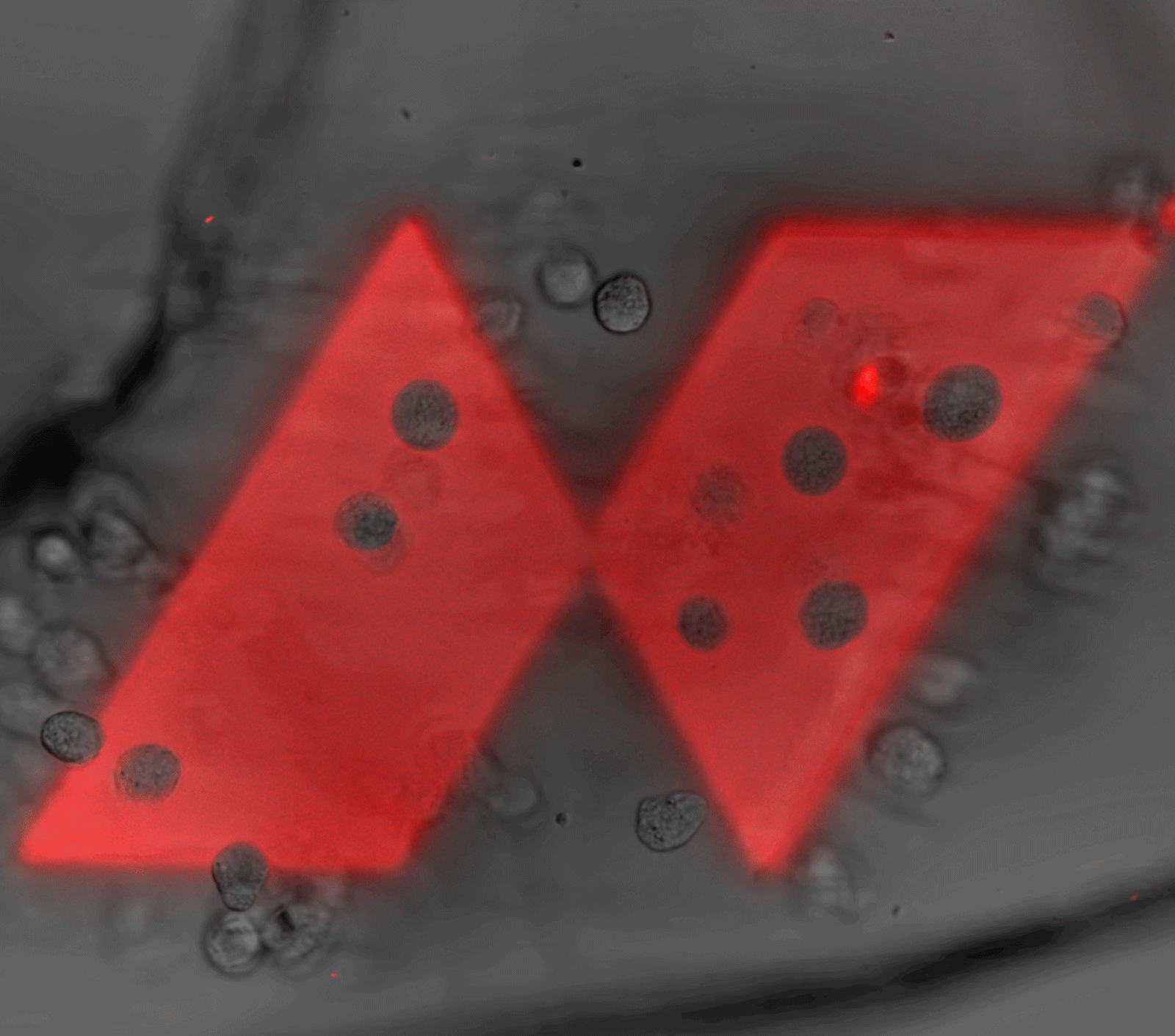Bring your ideas to life with
the highest precision 3D printing



Quantum X bio
the perfect match for biology
Next level of 3D bioprinting
Across all scales, from subcellular to millimeters, for biological models and biomedical devices
Expanded choice of substrates
Print as required on sterile cell culture dishes, microscope slides or inside microfluidic chips
Biomaterials and bioresins
Choose from hard acrylates, soft synthetic and natural bioresins, or create custom photoresins
The world’s most
accurate 3D bioprinter
The Quantum X bio is an exceptionally capable, versatile bioprinter with the highest resolution available. Powered by Two-Photon Polymerization (2PP) and grounded in engineering excellence, the proprietary technology is customized and reimagined through the eyes of a biologist.
The light-based 3D bioprinter offers essential features such as precise temperature and humidity control, HEPA-filtered airflow and an optional connection for pre-mixed air/CO2. A variety of functionalized biomaterials can be used to unlock a new level of bioprinting and effectively accelerate innovation in tissue engineering, microbiology, materials engineering and biomedical devices.

Advanced biomedical applications
Print virtually any 3D design with unmatched precision and speed, streamline your research, and benefit from a wide range of biocompatible acrylates, biomaterials, and bioresins available from Nanoscribe and our partners Advanced BioMatrix, CELLINK and BIO INX. Even organic and complex 3D structures can be precisely printed into microfluidic channels with just a touch screen tap.
This makes Quantum X bio the optimal two-photon lithography tool for creating physiologically relevant microenvironments for tissue engineering, custom scaffolds for cell studies, and many other innovative biomedical applications where precision, speed, biocompatible materials, and sterility matter.
Bioprinting at the microscale and beyond
Quantum X bio puts you at the forefront of exploring the full range of biological and biomedical applications. Take advantage of the bioprinting chamber, which creates a sterile environment with temperature and humidity control, a HEPA-filtered airflow and optional connection for pre-mixed air/CO2, ready to work with aqueous biomaterials and cells. The environmental controls and sterility achieved with the bioprinting chamber ensure the best performance when printing with water-based biomaterials, bioresins, and custom materials. With Quantum X bio, you are ready to explore cell encapsulation in bioresins for live cell printing.
Bioprinting library and data-driven workflow
With Quantum X bio, you benefit from Nanoscribe’s easy-to-use software with intuitive touchscreen controls, enhanced by our Bioprinting Model Library of verified models. Logging of temperature and humidity data during printing ensures cell-friendly conditions in the bioprinting chamber. Load, start and monitor your print job directly from the touchscreen of the device or remotely from your PC with nanoConnectX.
Technical features in brief
- 3D bioprinter based on Two-Photon Polymerization with cell-friendly 780 nm wavelength
- Bioprinting chamber that creates a sterile environment with temperature and humidity control and connection for pre-mixed air/CO2
- Sterile printing conditions within the bioprinting chamber provided by HEPA-filtered airflow, sterile consumables and sterilizable parts
- Various substrates including cell culture dishes, microscope slides, glass and silicon wafers, and microfluidic chips
- Wide range of printing materials available, including biomaterials and bioresins with biocompatibility according to ISO-10993-5
- Open system supports custom and third-party materials and bioresins
- Automated calibration and interface detection routines
- Bioprinting Model Library for quick start and inspiration
Technology and range of scales
- 2PP-based 3D bioprinting (direct laser writing)
- Two-Photon Grayscale Lithography (2GL®) available for amazingly fast and accurate surface patterning
- Nanoscale printing – subcellular feature size control in x/y direction down to 100 nanometers for certain photopolymers
- Microscale printing – with typical object dimensions from 50 to 700 micrometers
- Mesoscale printing – with structure sizes in the millimeter range
Be ready for in-chip printing
Quantum X bio is a powerful 3D Microfabrication system that provides the flexibility and capabilities to print on a variety of substrates, including microfluidic systems for organ- or lab-on-a-chip applications. With these capabilities, microfluidics meets cell culture, enabling the creation of organoids.
- Printing into microfluidic systems, including custom microfluidic channels and commercial microfluidic chips
- Enabled by Dip-in Laser Lithography (DiLL)
- Highly precise positioning of the prints within microfluidic systems
- High aspect ratio and high structures can be printed into open microfluidic channels and wells
- Touchscreen tap-to-align feature to easily set the print position within the channel or well
- Open system for custom resins, such as degradable materials
- Standard 3D designs available in Bioprinting Model Library
Explore the potential of 3D bioprinting






Facts and figures on Quantum X bio
- 3D bioprinter based on Two-Photon Polymerization
- The bioprinting chamber creates a sterile environment with temperature and humidity control, and HEPA-filtered airflow with optional connection for pre-mixed air/CO2, ready to work with aqueous biomaterials and cells
- Versatile system for microfabrication on a variety of substrates, e.g. cell culture dishes, microscope slides, glass and silicon wafers, and microfluidic chips
- High-resolution printing process with feature sizes down to 1 µm and below (material dependent) for subcellular structures
- Ready to explore live cell printing with custom bioresins
- Set up of custom materials with automated calibration; printing parameters are found using print job templates for parameter sweep
- Quick start and inspiration by Bioprinting Model Library
- Touchscreen and remote control software for ease of use
- Comprehensive support information and NanoGuide training videos
- Rapid prototyping with the highest precision and design freedom in a straightforward workflow
- Ideal for multi-user facilities: Modular system for a wide range of applications
Explore the full spectrum of biomedical applications
- Cell scaffolds
- Microtissues
- Living/4D materials
- Microfluidics
- Microneedle arrays
- Drug delivery vectors
- Micro/soft robotics
- Vascular models
- Topology for cell mechanics and migration
- Biosensors
- Materials engineering
Benchmark scores
| Feature size control 1 | down to 100 nm |
| Stitching-free part diameter | up to 4,000 µm |
| Maximum scan speed | 6.25 m/s divided by lens magnification |
| Live-cell printing viability | > 90 % |
General system properties
| Printing technology | Layer-by-layer 3D printing based on Two-Photon Polymerization (2PP) |
| Substrates | Microscope slides / microfluidic chips (3” x 1” / 76 x 26 mm2) |
| Photoresins | Open system for custom materials
|
| Maximum print area | 50 x 50 mm² |
Given values may vary depending on the photoresin and structure geometry.
1 100 nm feature size control in x/y direction, valid only for certain photopolymers
Easy to use and flexible
Discover the Quantum X bio software
Field-proven 3D bioprinting software for life science applications
How do you get from your 3D design to the final 3D printed structure? Nanoscribe’s software solutions guide users through the easy prepartion of their print jobs. Generate, upload, print, and monitor your print job directly from the device’s touchscreen or remotely from your PC.

Create your 3D print job with DeScribeX: The 3D print job development software takes you from 3D CAD model import to print job upload in just a few steps. Intuitive and easy by print preview and simulation.
Get inspired by the Bioprinting Model Library from CELLINK and Nanoscribe: Benefit from a comprehensive library of proven STL models that you can download and customize. This makes it really easy to print successfully.
Start your print job from the touchscreen: Quantum X bio’s intuitive touchscreen menu will guide you to a successful print job. Also benefit from key information such as hardware information, system status and printing progress. In addition, a live view of the printing process via three cameras gives you visual control at any time.
Stay connected with nanoConnectX: Start and monitor your print job from the office with nanoConnectX remote access software. This makes the Quantum X bio ideal for multi-user facilities.
Software facts
Benefit from a comprehensive library of STL models provided jointly by CELLINK and Nanoscribe. Instead of spending hours creating designs in CAD, simply select a design from our database, download it and customize it to your needs. The designs provided are inspired by biological and biomedical applications. The designs are scalable, so you can use them not only on the Quantum X bio but also on other bioprinters such as CELLINK’s BIONOVA X or BIO X6. This is your fast track to printing success.
DeScribeX is a print job development software for creating custom 3D prints. The built-in import wizard can load STL files as a widely used 3D CAD format. Pre-installed software printing parameter presets are perfect starting points that guide you to a successful print in just a few steps. The export function makes it easy to transfer the print job to the Quantum X bio remotely.
| Key feature | Benefits |
| 3D CAD model import wizard | Intuitive workflow generates suitable print job files from standard STL files |
| Print parameter presets | Ready-to-use preset parameters for optimal printing results right out of the box |
| Adaptive slicing | For surface refinement and improved shape accuracy |
| Parameter sweep | Easily find the perfectly matching print parameters for new materials and applications |
| Integrated Development Environment (IDE) | Experts can create and modify print files (GWL) for custom and sophisticated printing tasks |
| 3D preview and printing simulation | What you see is what you print! DeScribeX displays parameters such as print time, scan speed or laser power and simulates the entire printing process in detail |
Control and monitor the system with the Quantum X bio front panel touchscreen. It guides you to a successful print in just a few steps. Select your print project, then load your substrate and start printing.
| Key feature | Benefits |
| Three live cameras | Monitor the printing process online from three perspectives and stay informed about the current status of your print job |
| Stage control in x, y and z direction | Move the stage to any position on the substrate to define your print area |
| User-friendly print setup | Select resin and substrate, and start the print job with a single click |
| Project list | Keep track of the entire print job history |
| Automatic interface finder | Identify the interface of the substrate with submicrometer accuracy, for standard and custom materials. |
| Custom materials support | Configure and manage custom materials, including automated calibration routines |
| 3D rendered preview | A 3D simulation preview shows substrate and objective lens with automatic collision detection for better overview and safe operation |
| Easy to align | Double-tap on the screen to print at the right spot in microfluidic channels or patterned substrates with the “Tap to align” feature |
nanoConnectX is the remote access software for the Quantum X systems. It brings all the functions and display capabilities of the touchscreen to any computer connected online.
| Key feature | Benefits |
| Remote access to the system | Connect Quantum X bio to your computer, wherever you are |
| Use all features of the touchscreen | Prepare, control and monitor your print jobs from anywhere |
| Upload and download print jobs and reports | Access print-related files directly from your computer |
Quantum X bio offers
new features to power your ideas






Check out how
bioprinting and biomaterials printing come about...
How to best perform cell culturing experiments?
For cell culturing or cell seeding applications, microstructures are first printed using a material such as hydrogels or one of Nanoscribe’s biocompatible IP Photoresins. After printing, the structures are rinsed and cells are seeded onto the structures. Typically, the substrates are kept in incubators to monitor cell behavior over time.
Cell seeding is the most common technique used to combine 2PP-based microfabrication with cell research. Our publication database in the premium section of the website provides inspiration for research projects using Nanoscribe technology.
As an example of a cell seeding application, we printed 100 µm diameter microwells from IP-S and seeded them with NIH 3T3 fibroblast cells. The image below shows an animated vertical image stack of the stained cells in the microwells:

How to master live cell printing?
Live cell printing means direct laser writing with living cells in the resin – and getting them to survive the printing process. This is a major challenge because the cells are typically under stress during the processing inside the printer. To help you with this challenging task, Nanoscribe has implemented several features:
- Bioprinting chamber for a sterile, temperature and humidity controlled environment
- Use of custom hydrogel-based bioresins supported by humidity control with HEPA-filtered airflow and optional connection for pre-mixed air/CO2
- Printing of custom materials supported by composition and printing guidelines in the NanoGuide
- Cell-friendly wavelength (780 nm)
- Cell viability > 90 % proven
- Fast printing speeds to keep print jobs short
- Standard 3D designs available in Bioprinting Model Library
HEPA-filtered airflow is available for the most sensitive applications. While live cell printing has been performed with other bioprinting technologies, there are still relatively few reports on combining it with 2PP. Get ready to explore it with Quantum X bio!
The following structure was printed from a gelatin methacrylate-based bioresin loaded with NIH 3T3 fibroblast cells. The image series shows that the cells are alive and truly embedded in the printed structure.

Which materials are compatible with Quantum X bio?
A wide range of biocompatible materials is available for use:
- Nanoscribe’s IP/IPX Photoresin portfolio,
e.g. IP-Dip, IP-S, IP-Q, IP-PDMS, IP-Visio, IPX-S, IPX-Q and IPX-M - Nanoscribe GP-Silica
fused silica glass printing - Nanoscribe hydrogels & biomaterials,
e.g. BIO INX bioresins - BICO hydrogels & biomaterials,
e.g. PEGDA BioInk 500 (CELLINK), PhotoDextran and PhotoGel (Advanced BioMatrix) - Further hydrogels & biomaterials,
e.g. hyaluronic acid, PEGDA-based hydrogels, GelMA-based hydrogels, hydrogel mixtures
Note: Quantum X bio is designed as an open material system and allows you to use your custom or third-party materials, tailored to your application.
Note2: Other photoresins are available from Nanoscribe to enable fellow users for nonmedical applications.
How well does Quantum X bio compare with other microfabrication technologies?
The print speed metric refers to the number of voxels printed per second and is an indicator of how digital information is converted into solidified material. Quantum X bio features an extremely high speed of 1 million voxels per second.
The graph shown here compares Two-Photon Polymerization (2PP) to common additive manufacturing technologies in terms of printing rates and feature sizes. Measured by the absolute volume printing rate of 2PP, the serial process appears to lag behind the speed of other technologies. However, the technology features a high voxel printing rate compared to the fine voxel sizes it resolves.

Our whitepaper provides deeper insights into the performance of various high-precision 3D printing technologies. You can find it in the premium section of our website. Log in or register for free.
Why is it so easy to integrate Quantum X bio into production environments and multi-user facilities?
The advanced autofocus system reliably finds the interface of almost any substrate with maximum accuracy and repeatable print results. Three live-view cameras facilitate monitoring and direct laser writing process control. To simplify switching between hardware configurations, the Quantum X bio automatically detects the printheads and substrate holders. The bioprinting chamber is essential for creating a sterile, temperature and humidity controlled environment with HEPA-filtered airflow for live cell experiments and aqueous materials development. The chamber can be removed, providing the flexibility to work with further substrate holders.
Quantum X bio software controls and monitors print jobs in real time and supports intuitive operation via an interactive touchscreen control panel, or remotely from the office via nanoConnectX remote access software. This remote access also simplifies the work of entire user groups, such as members of a research group or a department, with a single or multiple systems, each of them accessing the Quantum X bio from their own computer.

Quantum X bio
Bring your ideas to life.
Redefining bioprinting.
We would be pleased to prepare a customized offer for you.
For this, please clarify the details with our sales experts.




